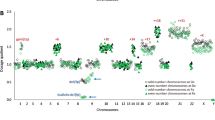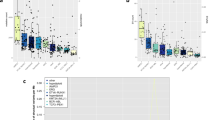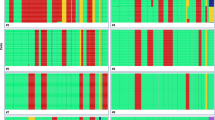Abstract
CD4+CD56+ haematodermic neoplasms (HDN) constitute a rare disease characterized by aggressive clinical behaviour and a poor prognosis. Tumour cells from HDN are leukaemic counterparts of plasmacytoid dendritic cells (pDCs). Despite increased knowledge of the ontogenetic origin of these tumours, the genetic causes and oncogenic signalling events involved in malignant transformation are still unknown. To delineate novel candidate regions and disease-related genes, we studied nine typical CD4+CD56+ HDN cases using genome-wide high-resolution array comparative genomic hybridization (CGH). Genomic imbalances, which were predominantly losses, were frequently detected. Gross genomic losses or gains involving an entire chromosome were observed in eight cases. The most frequent imbalances were deletions of chromosome 9, chromosome 13 and partial losses affecting 17p or 12p. Combinations of deletions of tumour suppressor genes (TSG), namely RB1, CDKN1B (p27), CDKN2A, (p16ink4a, p14arf) or TP53 (p53), were observed in all cases. These results indicate that deletion events altering G1/S regulation are crucial for HDN oncogenesis. Furthermore, in addition to frequent sporadic gene losses, in one case we observed a 8q24 interstitial deletion that brought MYC closer to miR-30b/miR-30d, which may be related to their deregulation. Taken together, these results indicate that in addition to frequent G1/S checkpoint alterations, various genetic events could contribute to the chemoresistance of the tumour.
This is a preview of subscription content, access via your institution
Access options
Subscribe to this journal
Receive 12 print issues and online access
$259.00 per year
only $21.58 per issue
Buy this article
- Purchase on Springer Link
- Instant access to full article PDF
Prices may be subject to local taxes which are calculated during checkout



Similar content being viewed by others
References
Willemze R, Jaffe ES, Burg G, Cerroni L, Berti E, Swerdlow SH et al. WHO-EORTC classification for cutaneous lymphomas. Blood 2005; 105: 3768–3785.
Feuillard J, Jacob MC, Valensi F, Maynadie M, Gressin R, Chaperot L et al. Clinical and biologic features of CD4(+)CD56(+) malignancies. Blood 2002; 99: 1556–1563.
Garnache-Ottou F, Feuillard J, Saas P . Plasmacytoid dendritic cell leukaemia/lymphoma: towards a well defined entity? Br J Haematol 2007; 136: 539–548.
Petrella T, Bagot M, Willemze R, Beylot-Barry M, Vergier B, Delaunay M et al. Blastic NK-cell lymphomas (agranular CD4+CD56+ hematodermic neoplasms): a review. Am J Clin Pathol 2005; 123: 662–675.
Pilichowska ME, Fleming MD, Pinkus JL, Pinkus GS . CD4+/CD56+ hematodermic neoplasm (‘blastic natural killer cell lymphoma’): neoplastic cells express the immature dendritic cell marker BDCA-2 and produce interferon. Am J Clin Pathol 2007; 128: 445–453.
Herling M, Jones D . CD4+/CD56+ hematodermic tumor: the features of an evolving entity and its relationship to dendritic cells. Am J Clin Pathol 2007; 127: 687–700.
Leroux D, Mugneret F, Callanan M, Radford-Weiss I, Dastugue N, Feuillard J et al. CD4(+), CD56(+) DC2 acute leukemia is characterized by recurrent clonal chromosomal changes affecting 6 major targets: a study of 21 cases by the Groupe Francais de Cytogenetique Hematologique. Blood 2002; 99: 4154–4159.
Dijkman R, van Doorn R, Szuhai K, Willemze R, Vermeer MH, Tensen CP . Gene-expression profiling and array-based CGH classify CD4+CD56+ hematodermic neoplasm and cutaneous myelomonocytic leukemia as distinct disease entities. Blood 2007; 109: 1720–1727.
Chaperot L, Bendriss N, Manches O, Gressin R, Maynadie M, Trimoreau F et al. Identification of a leukemic counterpart of the plasmacytoid dendritic cells. Blood 2001; 97: 3210–3217.
Chaperot L, Blum A, Manches O, Lui G, Angel J, Molens JP et al. Virus or TLR agonists induce TRAIL-mediated cytotoxic activity of plasmacytoid dendritic cells. J Immunol 2006; 176: 248–255.
Bastard C, Raux G, Fruchart C, Parmentier F, Vaur D, Penther D et al. Comparison of a quantitative PCR method with FISH for the assessment of the four aneuploidies commonly evaluated in CLL patients. Leukemia 2007; 21: 1460–1463.
Quintanilla-Martinez L, Kremer M, Keller G, Nathrath M, Gamboa-Dominguez A, Meneses A et al. p53 Mutations in nasal natural killer/T-cell lymphoma from Mexico: association with large cell morphology and advanced disease. Am J Pathol 2001; 159: 2095–2105.
Huppi K, Volfovsky N, Runfola T, Jones TL, Mackiewicz M, Martin SE et al. The identification of microRNAs in a genomically unstable region of human chromosome 8q24. Mol Cancer Res 2008; 6: 212–221.
Rucker FG, Bullinger L, Schwaenen C, Lipka DB, Wessendorf S, Frohling S et al. Disclosure of candidate genes in acute myeloid leukemia with complex karyotypes using microarray-based molecular characterization. J Clin Oncol 2006; 24: 3887–3894.
Hangaishi A, Ogawa S, Imamura N, Miyawaki S, Miura Y, Uike N et al. Inactivation of multiple tumor-suppressor genes involved in negative regulation of the cell cycle, MTS1/p16INK4A/CDKN2, MTS2/p15INK4B, p53, and Rb genes in primary lymphoid malignancies. Blood 1996; 87: 4949–4958.
Trovo-Marqui AB, Tajara EH . Neurofibromin: a general outlook. Clin Genet 2006; 70: 1–13.
Weir BA, Woo MS, Getz G, Perner S, Ding L, Beroukhim R et al. Characterizing the cancer genome in lung adenocarcinoma. Nature 2007; 450: 893–898.
Dallol A, Da Silva NF, Viacava P, Minna JD, Bieche I, Maher ER et al. SLIT2, a human homologue of the Drosophila Slit2 gene, has tumor suppressor activity and is frequently inactivated in lung and breast cancers. Cancer Res 2002; 62: 5874–5880.
Furuta J, Nobeyama Y, Umebayashi Y, Otsuka F, Kikuchi K, Ushijima T . Silencing of Peroxiredoxin 2 and aberrant methylation of 33 CpG islands in putative promoter regions in human malignant melanomas. Cancer Res 2006; 66: 6080–6086.
Her C, Zhao N, Wu X, Tompkins JD . MutS homologues hMSH4 and hMSH5: diverse functional implications in humans. Front Biosci 2007; 12: 905–911.
Tavera-Mendoza LE, Wang TT, White JH . p19INK4D and cell death. Cell Cycle 2006; 5: 596–598.
Niida H, Nakanishi M . DNA damage checkpoints in mammals. Mutagenesis 2006; 21: 3–9.
Davies SR, Watkins G, Mansel RE, Jiang WG . Differential expression and prognostic implications of the CCN family members WISP-1, WISP-2, and WISP-3 in human breast cancer. Ann Surg Oncol 2007; 14: 1909–1918.
Hamaguchi M, Meth JL, von Klitzing C, Wei W, Esposito D, Rodgers L et al. DBC2, a candidate for a tumor suppressor gene involved in breast cancer. Proc Natl Acad Sci USA 2002; 99: 13647–13652.
Radulescu RT . One for all and all for one: RB defends the cell while IDE, PTEN and IGFBP-7 antagonize insulin and IGFs to protect RB. Med Hypotheses 2007; 69: 1018–1020.
Chang TC, Yu D, Lee YS, Wentzel EA, Arking DE, West KM et al. Widespread microRNA repression by Myc contributes to tumorigenesis. Nat Genet 2008; 40: 43–50.
Martinez I, Gardiner AS, Board KF, Monzon FA, Edwards RP, Khan SA . Human papillomavirus type 16 reduces the expression of microRNA-218 in cervical carcinoma cells. Oncogene 2008; 27: 2575–2582.
Iorio MV, Visone R, Di Leva G, Donati V, Petrocca F, Casalini P et al. MicroRNA signatures in human ovarian cancer. Cancer Res 2007; 67: 8699–8707.
Gauwerky CE, Huebner K, Isobe M, Nowell PC, Croce CM . Activation of MYC in a masked t(8;17) translocation results in an aggressive B-cell leukemia. Proc Natl Acad Sci USA 1989; 86: 8867–8871.
Author information
Authors and Affiliations
Corresponding author
Additional information
Supplementary Information accompanies the paper on the Leukemia website (http://www.nature.com/leu)
Supplementary information
Rights and permissions
About this article
Cite this article
Jardin, F., Callanan, M., Penther, D. et al. Recurrent genomic aberrations combined with deletions of various tumour suppressor genes may deregulate the G1/S transition in CD4+CD56+ haematodermic neoplasms and contribute to the aggressiveness of the disease. Leukemia 23, 698–707 (2009). https://doi.org/10.1038/leu.2008.359
Received:
Revised:
Accepted:
Published:
Issue Date:
DOI: https://doi.org/10.1038/leu.2008.359
Keywords
This article is cited by
-
Blastic Plasmacytoid Dendritic Cell Neoplasm: Progress in Cell Origin, Molecular Biology, Diagnostic Criteria and Therapeutic Approaches
Current Medical Science (2021)
-
Recurrent 8q24 rearrangement in blastic plasmacytoid dendritic cell neoplasm: association with immunoblastoid cytomorphology, MYC expression, and drug response
Leukemia (2018)
-
Blastic plasmacytoid dendritic cell neoplasm: update on therapy especially novel agents
Annals of Hematology (2018)
-
Molecular profiling of blastic plasmacytoid dendritic cell neoplasm reveals a unique pattern and suggests selective sensitivity to NF-kB pathway inhibition
Leukemia (2014)
-
Plasmacytoid Dendritic Cells in Cutaneous Disorders
Current Dermatology Reports (2013)



